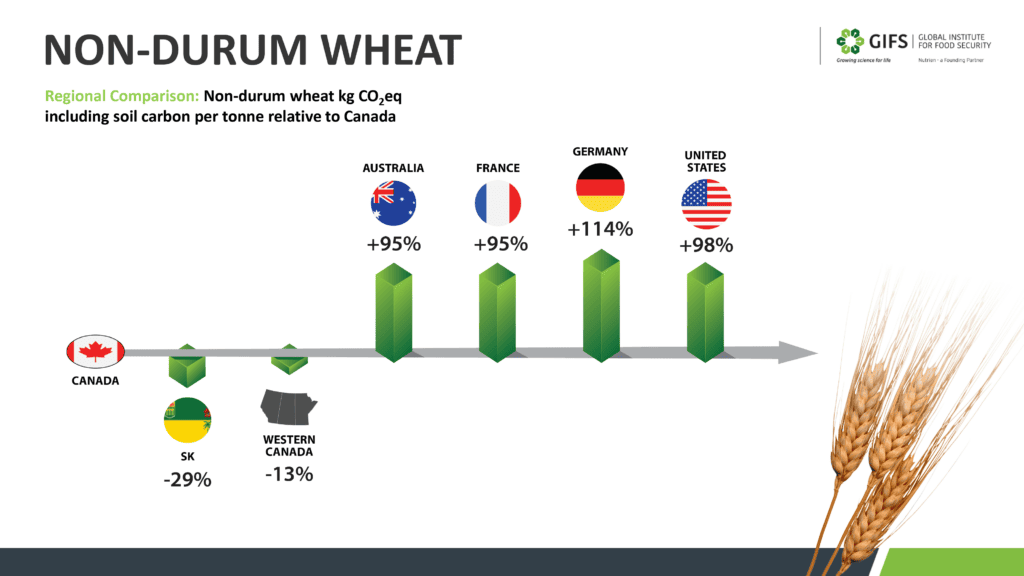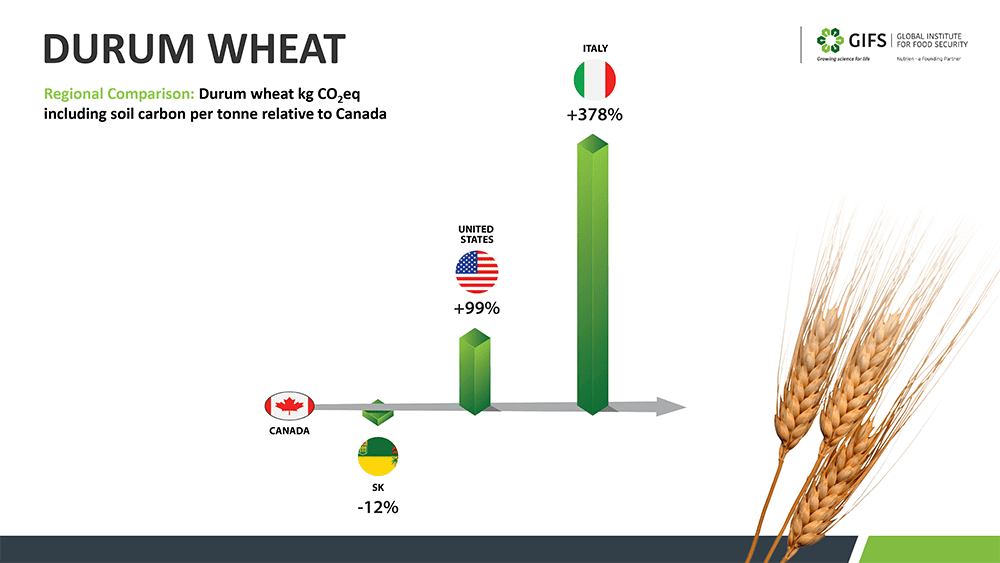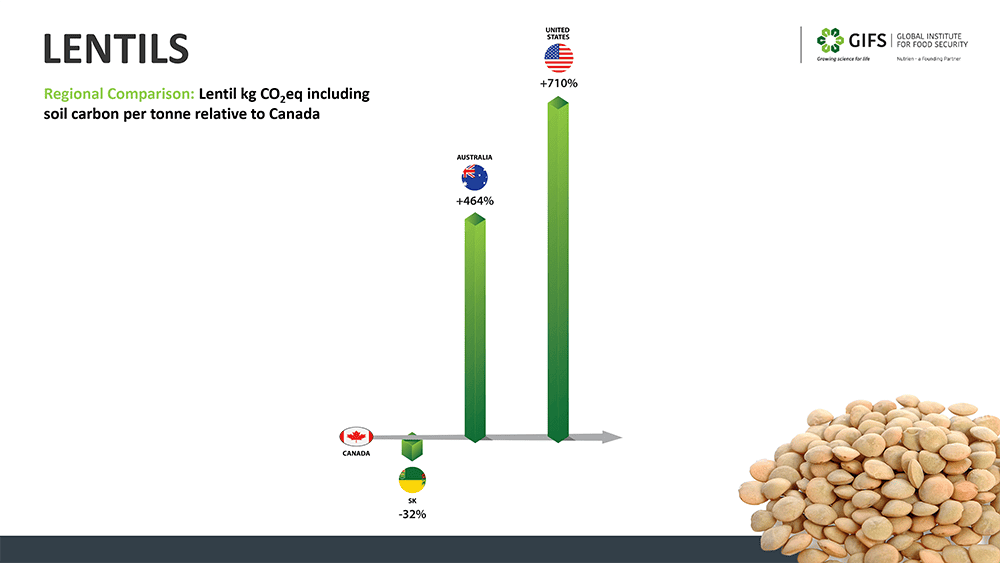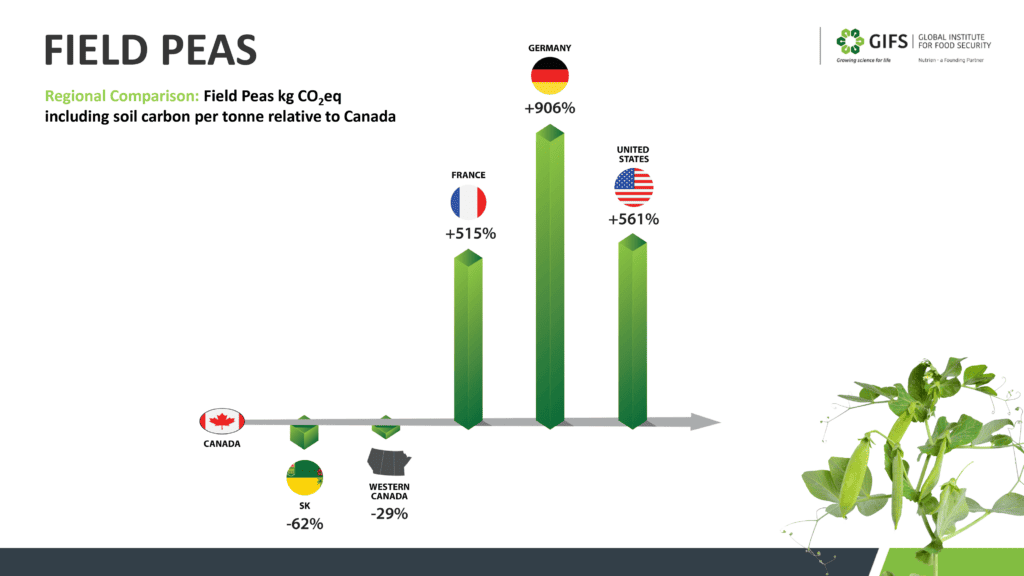Background
Canada is a leader in the sustainable production of safe and nutritious food. One of only a few net exporters of food globally, our agriculture sector employs an intensive production system that uses modern technologies and practices in a manner that is economically, environmentally and socially sustainable.
Through genetics, crop rotation, nutrient stewardship and other sustainable strategies, agricultural commodities from Canada – and Saskatchewan as well as Western Canada in particular – are some of the least carbon-intensive agri-food products in the world.

Sustainable Agriculture in Saskatchewan
Saskatchewan has achieved significant success in the sustainable production of food and is leading with agriculture and food production. Farming practices such as zero or minimum tillage, the adoption of herbicide-tolerant canola, a robust crop rotation and variable-rate application of fertilizer have transformed the province’s crop production sector (which contributes $26.3B to Canada’s GDP) from being a greenhouse gas (GHG) emitter to being a net carbon sink.
Many Saskatchewan producers practice the principles of regenerative agriculture, including minimal soil disturbance, robust crop rotation, covering the land, integrating livestock and the effective management of crop inputs. Scaling regenerative agriculture presents the opportunity to incentivize growers towards sustainable farming practices best suited to their regions.
These practices have placed Saskatchewan, Western Canada and Canada in a favourable position with sustainable crop production, when compared to globally competitive regions across the world.
GIFS Carbon Life Cycle Analysis
The Global Institute for Food Security (GIFS) commissioned studies in 2022 to examine the carbon footprint of agricultural production in Saskatchewan, Western Canada and Canada, and has compared those results to some of our closest competitors across the world. The results shed light on the agriculture sector’s contributions to sustainability and can help inform the development of science-based policy and regulations.
The comprehensive carbon life cycle analysis, which has been submitted for publication in a peer-reviewed journal, analyzes the greenhouse gas emissions of five key Canadian crops – canola, non-durum wheat and field peas in a first study by Bamber et al., and durum wheat and lentils in a second study by Bamber et al.– comparing Saskatchewan and Canada with globally competitive regions that export the same products.
Global Weighted Average (GWA) includes Australia, France, Germany, United States, Russia, Ukraine, and Italy, depending on the crop.
The results of this analysis show that widespread adoption of agricultural innovations by Canadian producers, particularly in Saskatchewan and Western Canada, have given the country a competitive advantage.
Methodology
This carbon life cycle analysis compiled data on the carbon dioxide equivalent emissions for the various activities that go into crop production, including:
- Transportation;
- Seed;
- Fertilizer and manure inputs;
- Crop inputs;
- Field activities;
- Energy emissions;
- Post-harvest work.
GIFS’ study also considers important data about the ability of our agricultural landscape to support soil-based carbon sequestration.
Canola

The Global Weighted Average (GWA) for canola is 1132 Kgs of CO2eq per tonne of production. Saskatchewan is 67% lower than the GWA for canola at 372 Kgs of CO2eq per tonne of production.
When we add up all of the CO2 equivalent emissions generated to produce one tonne of canola, Saskatchewan has the lowest carbon footprint by a wide margin, producing 67% lower greenhouse gas emissions than global competitors.
Our data shows that agronomic practices in Saskatchewan, Western Canada and Canada lead to soils in these regions capturing more carbon than other regions studied.
Through Saskatchewan’s widespread adoption of no-till farming practices, in which crops are seeded into the stubble of the preceding crop without tillage or with minimum/reduced tillage, the province’s fields have a remarkable capacity to sequester carbon – further improving its already positive results.
When we account for carbon sequestration, Saskatchewan has the smallest carbon footprint across all crop types and regions studied, confirming Saskatchewan agriculture is more sustainable than its global competitors and is best-in-class in Canada.
Non-Durum Wheat

The GWA for non-durum wheat is 561 Kgs of CO2eq per tonne of production. Saskatchewan is 62% lower than the GWA for non-durum wheat at 214 Kgs of CO2eq per tonne of production.
Canadian and Saskatchewan farmers generate significantly lower greenhouse gas emissions in non-durum wheat production.
Saskatchewan and Western Canadian farmers have a lower carbon footprint than Canada, at 29 per cent and 13 per cent lower respectively. Most regions studied are over 90 per cent higher than the Canadian average, with the exception of Russia which was 38 per cent higher than Canada’s average.
These numbers are a further result of agronomic practices that reduce field activities, fuel consumption and promote both soil health and agricultural productivity.
By a wide margin, Saskatchewan is the most sustainable producer of non-durum wheat in the study.
Durum Wheat

The GWA for durum wheat is 699 Kgs of CO2eq per tonne of production. Saskatchewan is 78% lower than the GWA for durum wheat at 155 Kgs of CO2eq per tonne of production.
When you include soil carbon sequestration, Saskatchewan’s carbon footprint in the production of durum wheat is significantly lower than competing regions across the globe.
Lentils

The GWA for lentils is 596 Kgs of CO2eq per tonne of production. Saskatchewan is 130% lower than the GWA for lentils at -177 Kgs of CO2eq per tonne of production. The carbon intensity of Saskatchewan-produced lentils is negative due to the high level of soil carbon, which exceeds the emissions associated with growing the crop.
Saskatchewan’s carbon footprint for the production of one tonne of lentils is significantly lower than competing jurisdictions and 32 per cent less than Canada’s footprint.
Saskatchewan is Canada’s largest producer of pulses, including lentils, which are an integral and integrated part of a crop-rotation program. They help break disease cycles, fix nitrogen in the soil and have end-use applications as a source of protein, mixed in with other foods for nutrition.
Field Peas

The GWA for peas is 965 Kgs of CO2eq per tonne of production. Saskatchewan is 96% lower than the GWA for peas at 40 Kgs of CO2eq per tonne of production.
In field peas, we see a clear picture again of the difference in agricultural practices both within Canada and across the globe.
Saskatchewan plants more than 50 per cent of Canada’s field pea acres and it does so in a remarkably efficient manner. In other jurisdictions across the world, greenhouse gas emissions for field peas are orders of magnitude higher – well over 1,000 per cent higher than both Canada and Saskatchewan. Once more, this is real-world, sustainable farming at scale, working to deliver sustainable economic, environmental and social outcomes.
Saskatchewan is Canada’s largest producer of pulses, including peas, which are an integral and integrated part of a crop-rotation program. They help break disease cycles, fix nitrogen in the soil and have end-use applications as a source of protein, mixed in with other foods for nutrition.
Saskatchewan’s sustainable cropping system promotes soil health. It retains moisture and nutrients, prevents erosion, and promotes on-farm profitability.
Did You Know?
- Research shows that Saskatchewan crop production has the lowest carbon footprint of competitive jurisdictions. Saskatchewan has a track record of maintaining healthy soils, sequestering carbon, and minimizing emissions by adopting innovative technology, implementing zero and minimum tillage, diversifying crop rotations, converting annual cropland to perennial cover, and investing in research.
- As reported in the 2023 National Inventory Report, on average, Saskatchewan producers sequester approximately 15.6 million tonnes of carbon annually¹ — almost 95 per cent of the total reported agriculture emissions in Saskatchewan². This is equivalent to taking 3.4 million cars off the road annually.
- Saskatchewan’s carbon footprint to produce one tonne of canola is 67 percent lower than global competitors.
- World-leading agronomic practices that reduce field activities and support carbon sequestration mean Canadian growers — led by Saskatchewan farmers — are the most sustainable producers of non-durum wheat.
- No-till farming supports reduced fertilizer applications in Saskatchewan field peas, resulting in a carbon footprint that is a small fraction of that of any other region studied in GIFS’ carbon life cycle analysis.
¹ Using a five-year average (2017-2021).
² The National Inventory Report (NIR) uses a continuous improvement model, whereby each year, using updated data, new and improved methodologies, and the refinement of indicators and coefficients, all data back to 1990 is updated for accuracy. As a result, the previous 2022 NIR figure for agricultural net sequestration (12.8 MT) was updated to 16.3 MT. Due to this variability, the Province of Saskatchewan uses a five-year average to report on emissions and sequestration. There is a two-year lag in reporting numbers in the NIR, hence the 2023 NIR is reporting numbers for 2021.
The Saskatchewan Advantage

Saskatchewan is Canada’s breadbasket and contains over 40 per cent of the country’s arable land, the second-largest beef cattle herd and 30 per cent of its agriculture biotechnology industry. Located in the heart of Canadian and Western Canadian agriculture, and a major contributor to its agriculture and food sector, it is also the location of several leading-edge science and research organizations and is an agriculture technology (agtech) powerhouse.
With a thriving agri-food ecosystem, the entire sector value chain resides in the province, from researchers to producers, agtech, suppliers (primary and value-add), food processors, retailers and everything in between. The presence of this end-to-end value chain makes Saskatchewan an ideal location from which to scale an agri-food business.
Resources
Publications
- Bamber et al. 2023: Carbon footprint analysis of Saskatchewan and Canadian field crops and comparison to international competitors. • Download (PDF)
- Bamber et al. 2023: Appendix: Transportation-to-market break-even distances. • Download (PDF)
- Bamber et al. 2023: Carbon footprint analysis of Saskatchewan and Canadian field crops and comparison to international competitors: Part 2. • Download (PDF)
